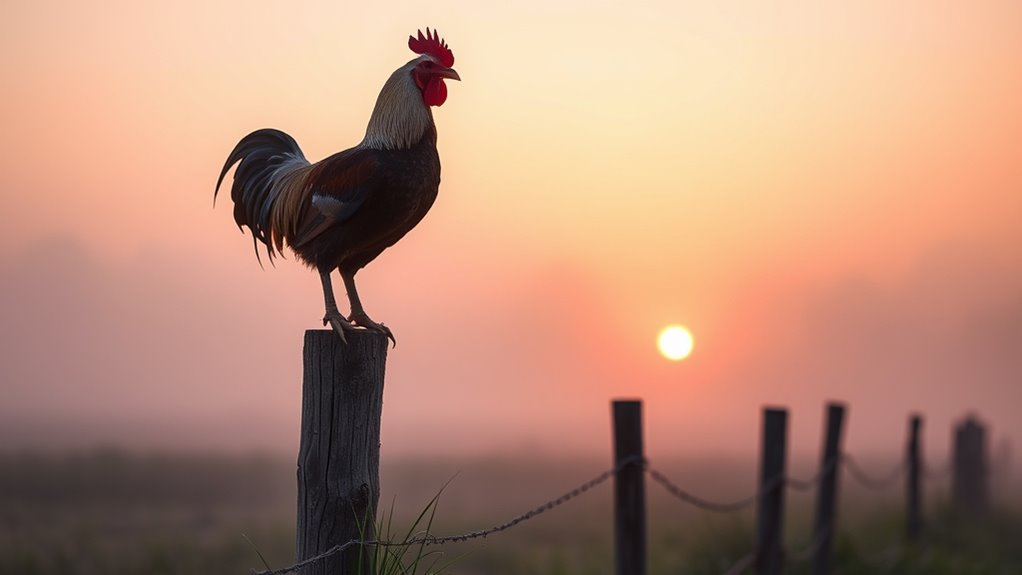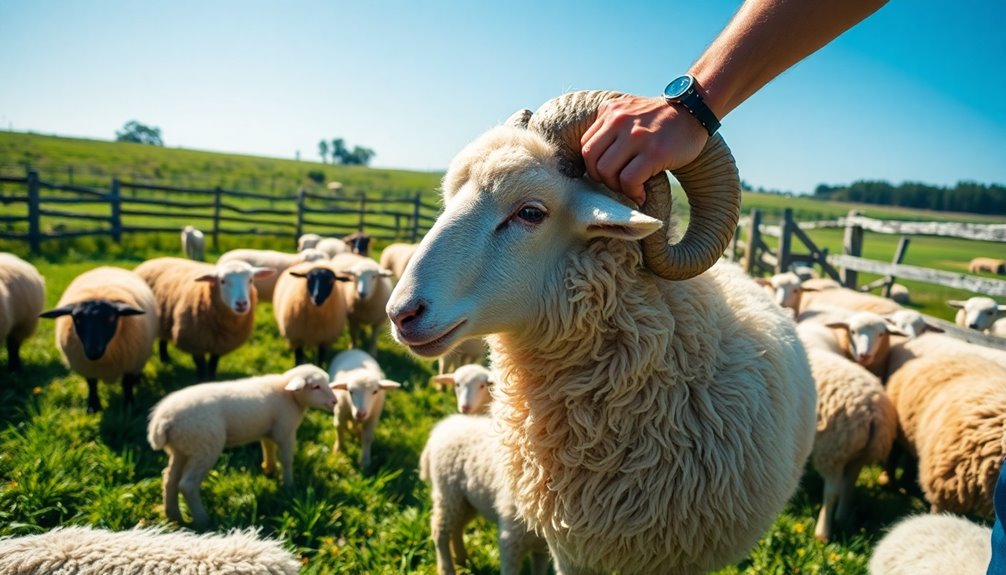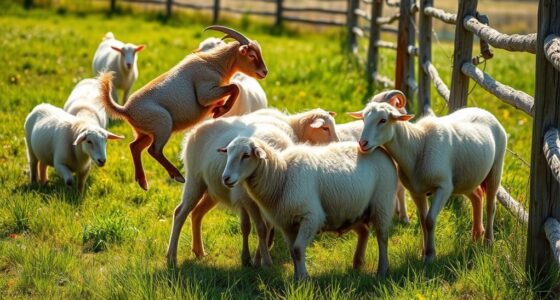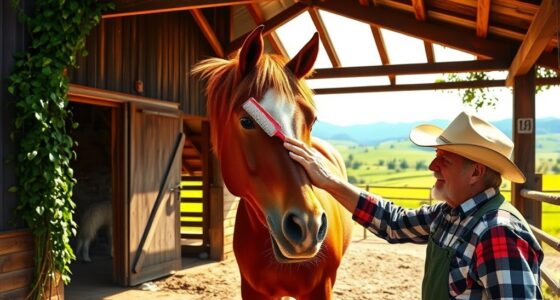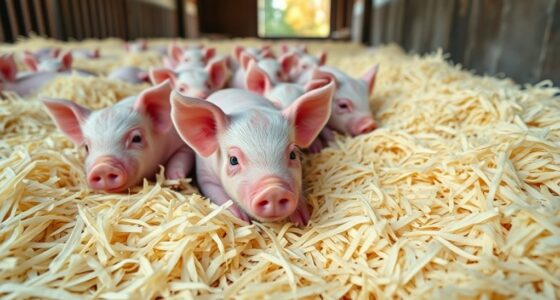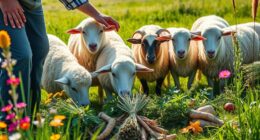Roosters typically start to crow between 4 to 6 months old, while smaller breeds like bantams can crow as early as 3 months. Their first crow may sound like a wheeze, but it evolves into a full crow over time. Factors like nutrition, social interactions, and environmental stability play crucial roles in this timing. Understanding these influences helps predict when your rooster will start crowing, and there's more fascinating information to discover about their behavior.
Key Takeaways
- Roosters typically begin crowing between 4 to 6 months of age, though bantams may start as early as 3 months.
- Environmental factors like stress and nutrition can influence the timing of when roosters start to crow.
- Consistent lighting conditions and exposure to natural light help regulate a rooster's crowing behavior.
- Social interactions with other chickens can accelerate vocal development, prompting earlier crowing.
- The dominant rooster usually crows first, establishing hierarchy and influencing subordinate roosters' crowing schedules.
Age of Maturity and Initial Crowing
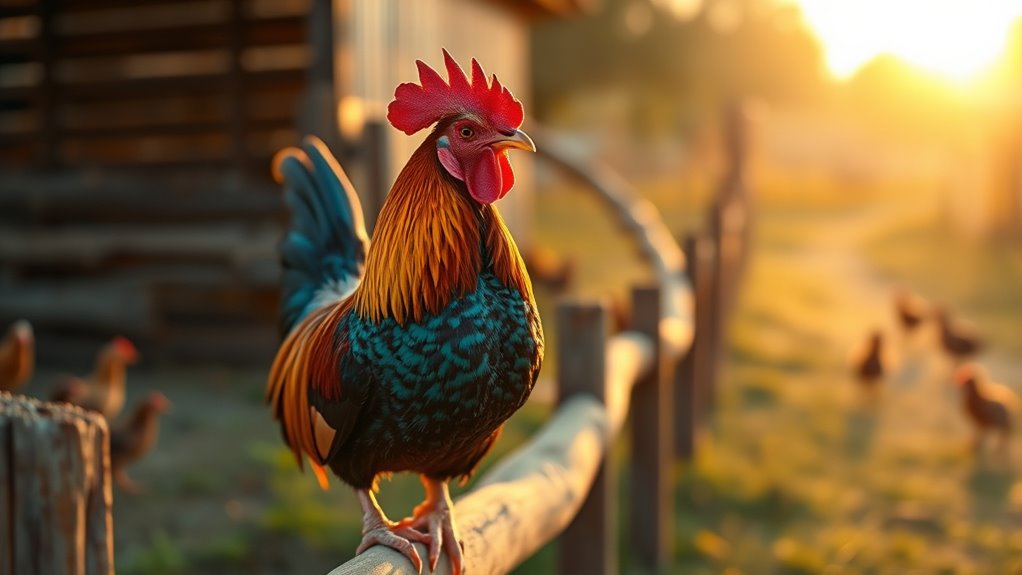
As roosters reach maturity, you'll notice they typically start crowing between 4 to 6 months of age.
Roosters usually begin crowing as they mature, typically between 4 to 6 months of age.
However, this can vary by breed, with smaller breeds like bantams sometimes crowing as early as 3 months.
Environmental factors also play a role; stress and social interaction can influence when a rooster begins to crow.
Proper nutrition is crucial, as it supports healthy development and can impact the timing of crowing.
Additionally, consistent lighting conditions help regulate their growth and behaviors.
Understanding these factors will give you insight into your rooster's development and help you anticipate when he might vocalize for the first time.
Keep an eye out for these signs as your rooster matures!
Developmental Indicators of Crowing
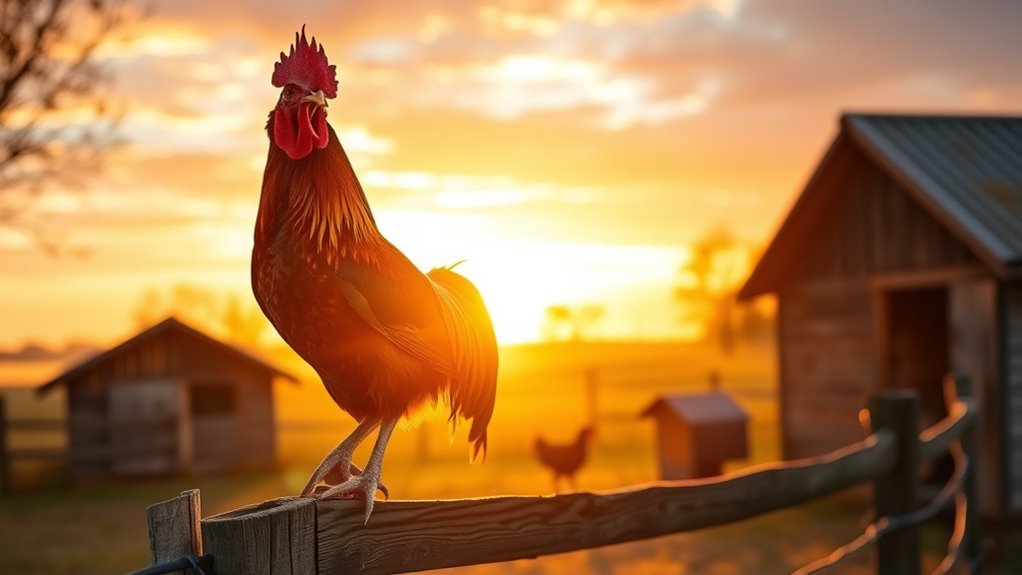
Understanding the developmental indicators of crowing can help you gauge your rooster's maturity. Different breeds mature at varying rates, so keep that in mind.
Environmental factors also play a role; if your rooster experiences stress, it might delay crowing, while a stable environment encourages it.
Social dynamics matter too—interaction with other chickens can speed up vocal development.
Look for physical signs like thicker legs and developing spurs, which indicate growth.
Initially, your rooster's crow may sound like a wheeze, but it'll evolve into a full crow over time.
Monitoring these indicators will give you valuable insights into when you can expect your rooster to start crowing confidently.
The Role of Circadian Rhythms
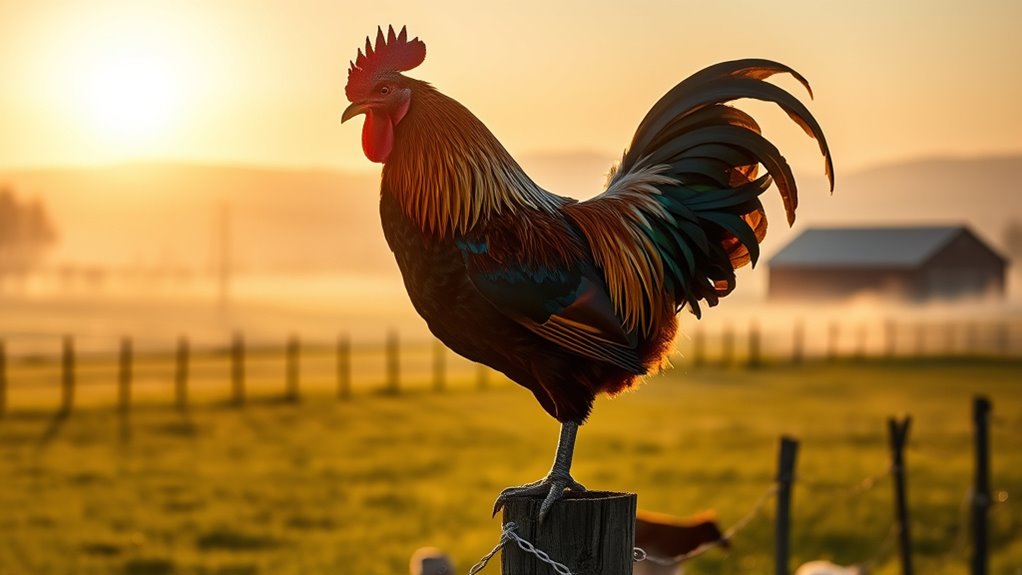
Roosters crow consistently at dawn, thanks to their internal circadian clock that governs their behavior. This clock regulates their crowing, ensuring it aligns with the natural light-dark cycle.
While their internal clock is the primary driver, light exposure can trigger crowing, especially if it mimics dawn. Roosters thrive on regular sunlight; without it, their crowing becomes irregular over time.
They often crow before dawn, showcasing their innate timing abilities. Even in controlled environments, they maintain a 24-hour crowing schedule.
External stimuli, like light or the crowing of fellow roosters, can also influence their behavior, but the strongest responses occur around dawn, reinforcing the significance of their circadian rhythms in crowing patterns.
Social Hierarchy and Crowing Behavior
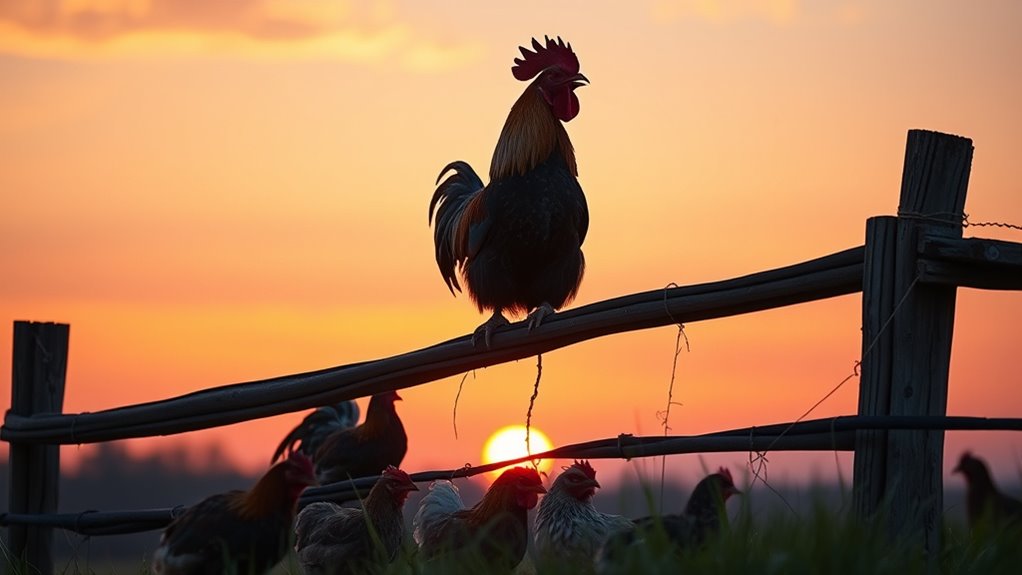
While the internal circadian clock plays a crucial role in when roosters crow, their social hierarchy significantly influences this behavior.
In a flock, the highest-ranking rooster typically crows first, establishing dominance and signaling his territory. Subordinate roosters follow in a descending order, adjusting their crowing to align with the dominant rooster's schedule.
The dominant rooster crows first, setting the stage for a social hierarchy among subordinate roosters.
This pecking order not only controls access to resources but also suppresses the crowing of lower-ranking birds, maintaining social stability. When a dominant rooster is removed, the second-ranking rooster quickly adapts and takes over the first crowing position.
Crowing serves as both communication and a way to assert dominance, reinforcing the social structure that keeps the group organized and cohesive.
Environmental Influences on Crowing
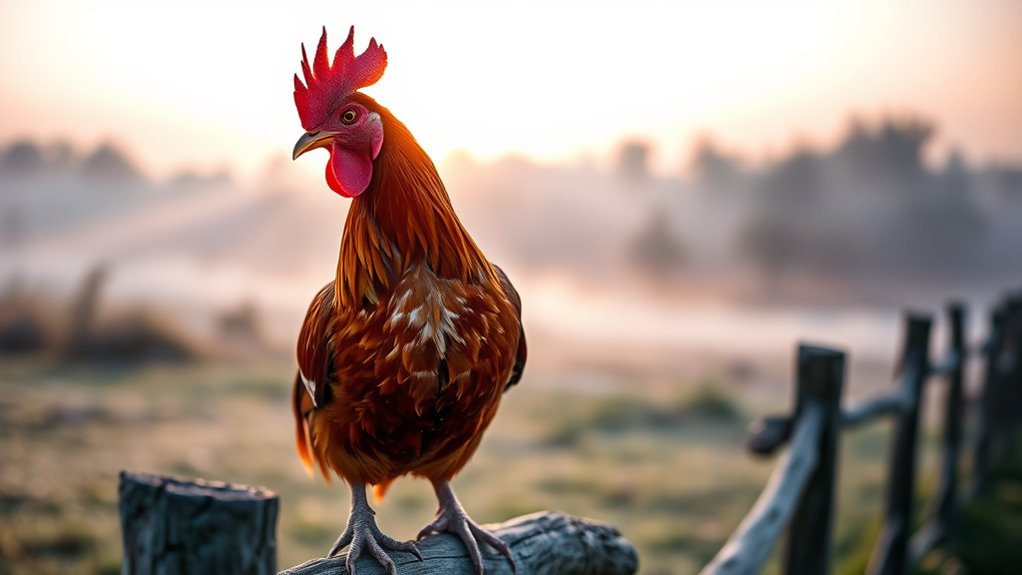
Crowing behavior in roosters isn't only shaped by their social hierarchy but also significantly influenced by their environment.
Light levels play a crucial role; roosters crow in response to changes in light, often triggered by dawn or even artificial lighting. You might notice that storms can also cause unexpected crowing due to shifts in natural light.
Their internal biological clock, which runs about 23.8 hours, keeps them crowing consistently, even without external cues.
Seasonal variations further affect crowing patterns, with increased activity during spring and reduced frequency in fall and winter.
Sudden noises or disturbances can also prompt crowing at unusual times, showing how sensitive roosters are to their surroundings.
Communication Through Crowing

Communication in the avian world is fascinating, and crowing serves as a vital tool for roosters to convey messages within their flock.
You'll notice that roosters crow to mark their territory, signaling to others that an area is claimed. Dominant roosters assert their status through their crows, while also keeping their hens coordinated and informed about their location.
If danger approaches, a high-pitched crow alerts the flock to potential threats. Additionally, specific crowing patterns can attract hens and indicate a rooster's readiness to mate.
Through these various types of crows, roosters establish social hierarchies and maintain flock safety, demonstrating how integral crowing is to their communication and social dynamics.
Physiological Mechanisms Behind Crowing
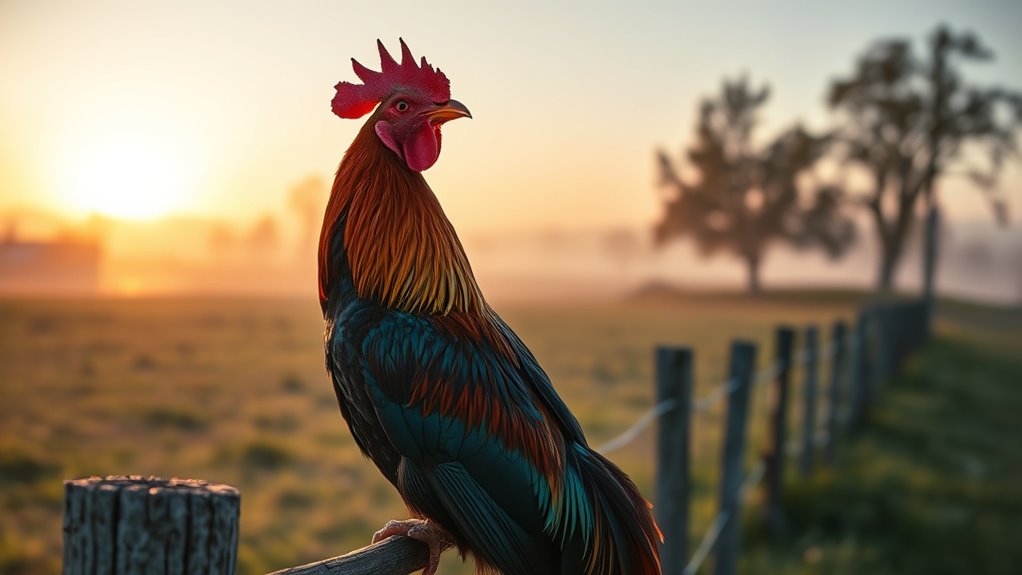
Understanding the physiological mechanisms behind crowing reveals a complex interplay of hormones, neurotransmitters, and brain structures. Testosterone is crucial for activating genes related to crowing, particularly the cholecystokinin B receptor (CCKBR).
In the midbrain's nucleus intercollicularis, this receptor is key to crowing behavior. When cholecystokinin (CCK) binds to CCKBR, it induces crowing; this system can also be activated under social stress.
Roosters' anatomical adaptations protect their ears from their loud calls. Their vocal apparatus, including the beak and trachea, is essential for producing the sound.
Additionally, an internal circadian clock regulates crowing, often synchronized with dawn, while genetic expression ensures only roosters exhibit this behavior due to testosterone's influence.
Variability in Crowing Patterns
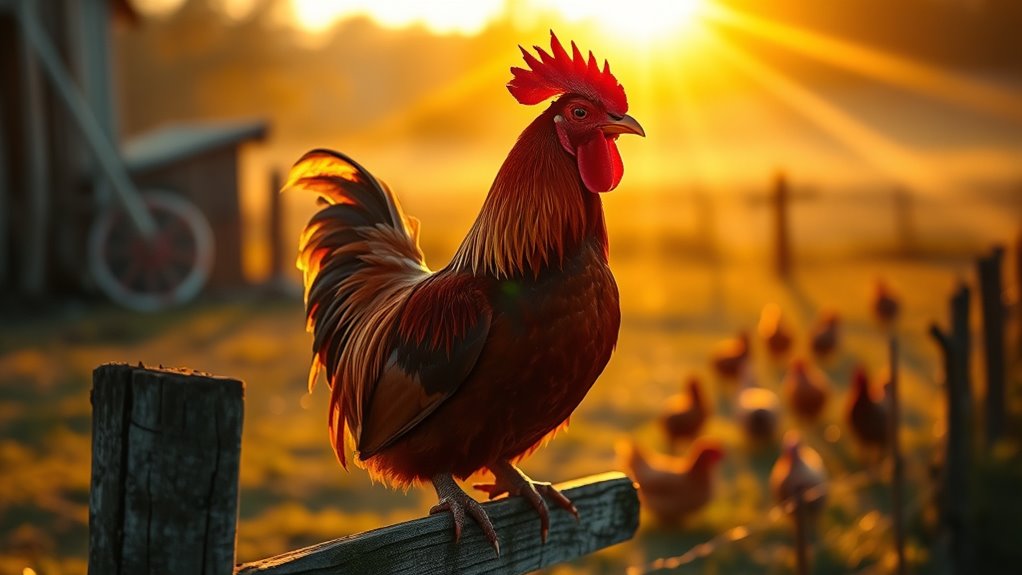
While many might assume roosters crow only at dawn, their crowing patterns are surprisingly variable and influenced by a range of factors.
Roosters typically peak their crowing around dawn, but they can start crowing about two hours before light appears, thanks to their internal circadian clock.
Throughout the day, they crow in response to various external stimuli, like noises or changes in light.
Seasonal changes also play a role, with increased crowing in spring and less in winter.
Additionally, social dynamics affect crowing; dominant roosters often crow first, while subordinates follow.
Factors Affecting Crowing Frequency
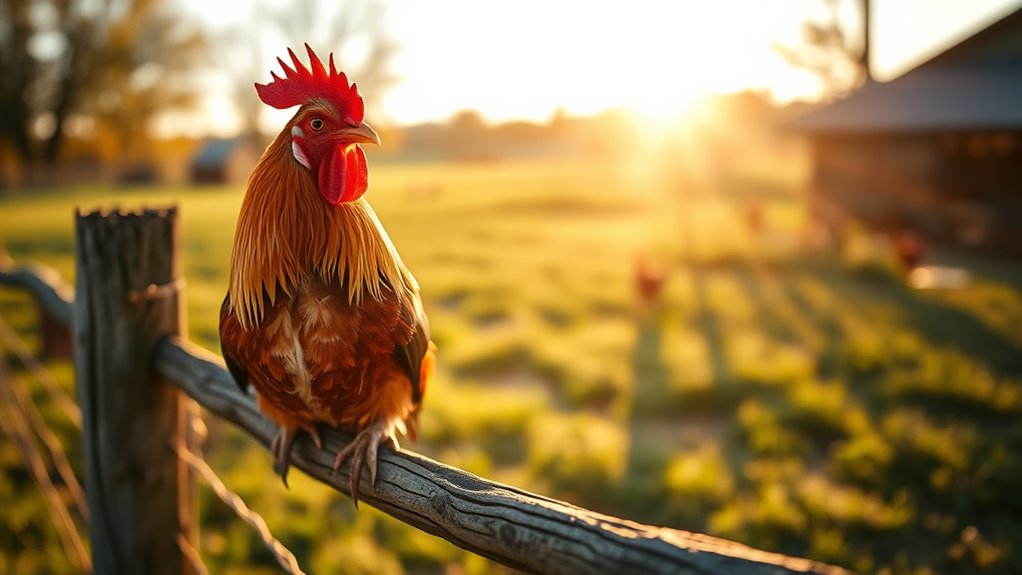
Roosters don't just crow at dawn; their crowing frequency is shaped by several factors that vary from breed to environment.
Different breeds exhibit distinct crowing patterns, with some being more vocal than others. Genetics play a crucial role, influencing the intensity and pitch of their calls.
Different rooster breeds showcase unique crowing habits, influenced by genetics that affect both call intensity and pitch.
Light levels also impact crowing; natural and artificial light can trigger them at different times.
Social dynamics matter too—dominant roosters tend to crow more frequently, setting the tone for others.
Additionally, age affects how often they crow, with younger roosters often being more vocal.
Finally, external stimuli like noises or environmental changes can prompt unexpected crowing.
All these factors create a unique crowing experience for each rooster.
Frequently Asked Questions
Can Roosters Crow at Night?
Yes, roosters can crow at night. If they encounter bright lights or sudden noises, you might hear them crowing after dark.
It's their way of signaling potential threats or asserting dominance. Some roosters are naturally more vocal, so you could notice this behavior more in certain breeds.
If you provide a stable environment, it may help reduce nighttime crowing, but it's not uncommon for them to react to disturbances at any hour.
Do Hens Respond to a Rooster's Crowing?
Yes, hens definitely respond to a rooster's crowing. When you hear a rooster crow, it often signals the hens to follow him for foraging or safety.
They rely on his calls to stay coordinated and alert. If a rooster's behavior becomes dominant or unsatisfactory, hens might express their discontent through vocalizations.
How Far Can a Rooster's Crow Be Heard?
Imagine a rock concert where a chainsaw suddenly joins in—welcome to the world of rooster crows!
You'll find that a rooster's crow can reach an ear-splitting 143 decibels at point-blank range. Depending on your surroundings, you might hear it from a quarter-mile away or just around the corner.
Obstacles like trees or buildings? They can muffle the sound. So, if you're near a rooster, you better be ready for a loud wake-up call!
Do Different Breeds of Roosters Crow Differently?
Yes, different breeds of roosters do crow differently.
You'll notice variations in volume, pitch, and frequency based on the breed. Smaller breeds often crow more frequently and may mature faster, while larger breeds tend to have deeper, less frequent crows.
Environmental factors can also influence their crowing patterns.
What Are the Consequences of Excessive Crowing?
Imagine waking up to a relentless chorus of crowing echoing through your neighborhood at dawn.
Excessive crowing can strain your relationships with neighbors, leading to noise complaints and potential legal troubles. It disrupts your sleep and lowers your quality of life.
Environmental triggers like new sounds or seasons can escalate this behavior. To manage it, you might need to implement sound barriers or consider breeds known for being quieter, ensuring peace in your home.
Conclusion
In summary, roosters start to crow at different ages and for various reasons. They crow to communicate, establish their place in the pecking order, and respond to their environment. Understanding their crowing patterns helps you appreciate their unique behaviors. So whether you're waking up to their morning calls or enjoying their antics throughout the day, remember that each crow tells a story of maturity, rhythm, and social life in the world of roosters.

